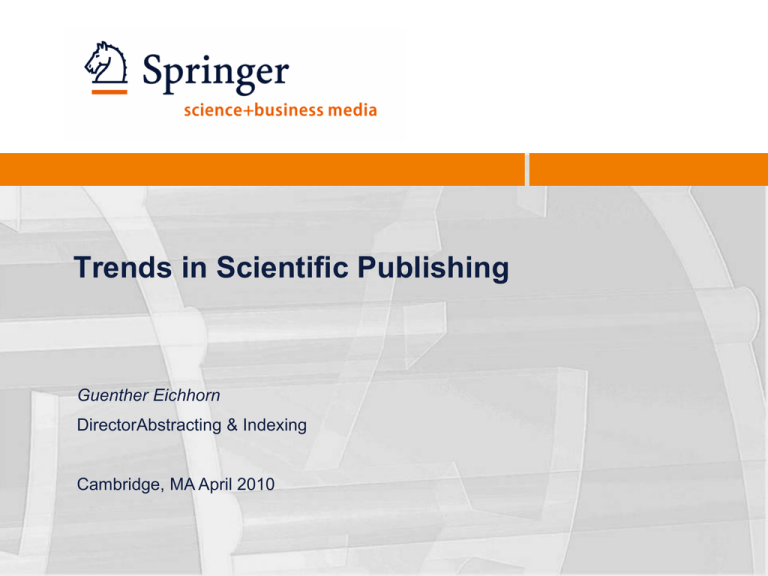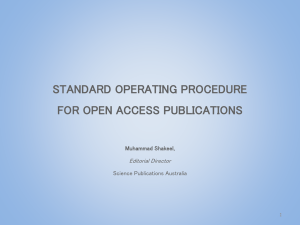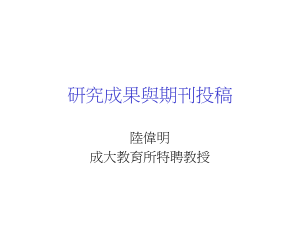PPT
advertisement

Trends in Scientific Publishing Guenther Eichhorn DirectorAbstracting & Indexing Cambridge, MA April 2010 Trends in Scientific Publishing Overview • Digitization • Searching • The role of a scientific publisher • New Products and Capabilities • Business models are changing • Future 2 Trends in Scientific Publishing 3 All content digitized 146,000 articles/yr 1996 2004 “Digitize all journals going forward!” 1842 Springer-Verlag founded “Digitize all journals going backward!” Journals 1860 1870 1880 1890 1900 1910 1920 1930 1940 1950 1960 1970 1980 1990 2000 2010 Books 2006 “Digitize most books going forward!” 2009 “Digitize all books going forward and a lot of books going backward!” 5,000 books/yr Trends in Scientific Publishing Our audience is reading digital… 4 Trends in Scientific Publishing Google is most popular search engine 5 Trends in Scientific Publishing 6 Google’s share of traffic by Springer site 65% 79% 83% Trends in Scientific Publishing 7 Different role of Publishers First hand distribution of primary scholarly information has disappeared from the publisher‘s list of service in some disciplines (arXiv). Trends in Scientific Publishing Quality Assurance: Peer-Reviewing 8 Trends in Scientific Publishing 9 Metadata Metadata for scientific documents comprise a number of attributes: authorship, affiliation, journal name (ISSN), manuscript number or pagination, article category, keywords, citation line, year of publication, DOI, references… The uniform quality and international standards of metadata are of paramount importance in a global e-publishing system. A Publisher like Springer distributes the metadata, across all disciplines, to hundreds of various abstracting and indexing services, such as: – Web of Science (Thomson ISI) – Scopus (Elsevier) – Medline, PubMed (US National Library of Medicine) – INSPIRE – ADS Consistency is also needed for durable archiving (e.g. by Portico). Trends in Scientific Publishing 10 Improve on core products Journals innovation Books innovation Platform innovation Trends in Scientific Publishing 11 Trends in Scientific Publishing Develop database publishing capability 12 Trends in Scientific Publishing 13 Develop value-added workflow tools http://www.authormapper.com/search.aspx?q=nanoelectronics Trends in Scientific Publishing 14 Experiment with social media for societies 353 Members 2,262 Members Trends in Scientific Publishing Experiment with social media wiki 15 Trends in Scientific Publishing 16 Business Models: Subscription versus Open access • Subscription model: – published information is purchased for use by (mainly) libraries – copyright is transferred by the authors to the publisher Access to scientific article output has never been better; thousands of institutes worldwide have access to SpringerLink. • Open Access model – Upfront payment of publication services including subsequent free access – copyright is kept by author (only publishing license) Springer is at the forefront of open access publishing; Springer Open Choice, consortia-paid open access, complete (author-paid) open access journals, BioMed Central. Trends in Scientific Publishing 17 Collaboration in ORCID • ORCID (Open Researcher & Contributor ID) attempts to provide unique author identification. • Difficult to achieve. • Long range effort Trends in Scientific Publishing 18 eFirst publishing • Electronic final article published immediately –Includes issue and page/article numbers • Summary print issue available at year-end –Either part of subscription or pay-on-request Trends in Scientific Publishing 19 Enhanced electronic publishing • PDF still mimics many features of “paper copies” • Instead, use basically only mark-up language based means to create online articles which are significantly enriched by incorporating new features: – Downloadable spreadsheets to enable readers to work directly with data presented – Semantic markup of textual terms and link to third-party information sources – Interactive figures – Movies – citations which include a pop-up containing the relevant quotation from the cited article – Sortable reference lists, etc. Trends in Scientific Publishing 20 Quality Assurance: Plagiarism – State of the Art • • • Peer-review can not always uncover plagiarism Electronic technologies greatly facilitate plagiarism – this is on the rise! Joint solution by publishers: Cross-Check for Cross-Ref members – Joint database fed by all publishers with defined access rule – Checks published (protected) content (current + archived, 8+ years) The result, marked-up textual overlaps between documents, needs interpretation. Interpretation issues range from self-plagiarism to cultural issues : strong textual overlap need not mean plagiarism but possibly betrays the generic problem of nonnative speakers. Trends in Scientific Publishing 21 Quality Assurance : II. Plagiarism – Future Challenges – Challenge 1: Adapt all web-based manuscript handling and peer-reviewing systems to incoporate the possibility to automatically query the cross-ref database and to return the results to the editorial offices – Challenge 2: Compare submitted document not only with published literature in the protected database, but also with manuscripts in submission stage elsewhere: detection of multiple submissions! – Challenge 3: Come up with smart plagiarism detecting tools; articles with copied results but rewritten texts are not detected by current tools. a reminder of the complexity of e-publishing…








